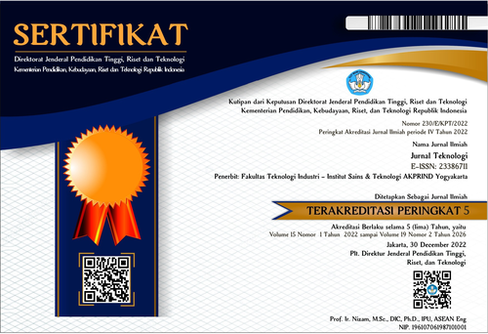Optimasi Proses Pembuatan Asap Cair dari Tempurung Kelapa Melalui Response Surface Methodology (RSM)
DOI:
https://doi.org/10.34151/jurtek.v16i2.4552Keywords:
carbonyl content, liquid smoke, optimization, RSMAbstract
Response Surface Methodology (RSM) is a collection of mathematical and statistical techniques that are useful for analyzing complex processes that are influenced by several variables. This research aimed to apply RSM in optimizing the process of making liquid smoke from coconut shell pyrolysis. Optimum process conditions were reviewed based on the content of several functional compounds in liquid smoke including carbonyl content, phenol content, and acid content. The process variables comprised pyrolysis temperature (within the temperature range of 350 oC as low level (-1) and 450 oC as high level (+1)), pyrolysis time (within the range of 45 minutes as low level (-1) and 75 minutes as high level (+1)), and the water content in the coconut shell (within the range of 10% water content as low level (-1) and 20% as high level (+1)). This study results showed that the best carbonyl content in liquid smoke was 3.58% at temperature of 395 oC, pyrolysis time of 60 minutes, and water content of 16%. The optimum phenol content of 5.55% was achieved with a combination of pyrolysis time of 65 minutes and water content of 15.5%. Based on the acid content, an optimum value of 19.55% was obtained at a combination of pyrolysis time of 62 minutes and water content of 15.5%. The hypothesis H0 could be accepted statistically for the carbonyl content.
Downloads
References
Anonim. 2017. Luas Tanam dan Produktivitas Beberapa Tanaman Perkebunan di DIY pada Tahun 2016. Yogyakarta: Badan Pusat Statistik DIY.
Box, G.E.P., Hunter, J.S., dan Hunter, W.G. 2005. Statistics for Experimenters: Design, Innovation, and Discovery (2nd ed.). New Jersey: John Wiley & Sons, Inc.
Diah L.A. dan Rodiah N.S. 2010. Liquid Smoke and Its Applications for Fisheries Products. SQUALEN Bulletin of Marine and Fisheries Postharvest and Biotechnology. 5(3): 101.
Girard. 1992. Technology of Meat and Meat Product Smoking. New York: Ellis Harwood, 162–201.
Montgomery, D.C. 2013. Design and Analysis of Experiments (8th ed.). New Jersey: John Wiley & Sons, Inc.
Pszczola. 1995. Tour Highlights Production and Uses of Smoke Based Flavors. Food Technology (1): 70–74.
Ramakrishnan, S. dan Moeller, P. 2002. Liquid Smoke: Product of Hardwood Pyrolysis. Chemistry, Environmental Science.
Tranggono, dkk. 1996. Identifikasi Asap Cair dari Berbagai Jenis Kayu dan Tempurung Kelapa. Jurnal Ilmu dan Teknologi Pangan I (2): 15–24.
Downloads
Published
How to Cite
Issue
Section
License
Copyright (c) 2023 Siti Diyar Kholisoh

This work is licensed under a Creative Commons Attribution 4.0 International License.
Jurnal Teknologi provides immediate open access to its content in order of making research freely available to the public to support a global exchange of knowledge. All articles published in this journal are free for everyone to read and download, under licence CC BY SA.
Benefits of open access for the author, include:
- Free access for all users worldwide.
- Authors retain copyright to their work.
- Increased visibility and readership.
- No spatial constraints.




















